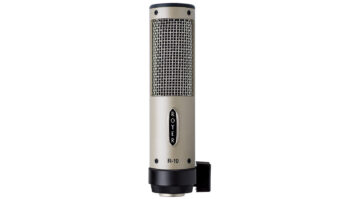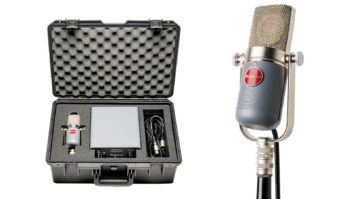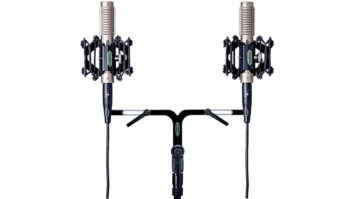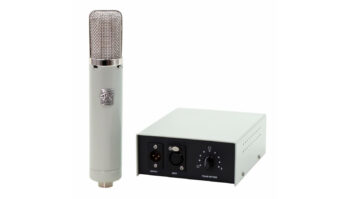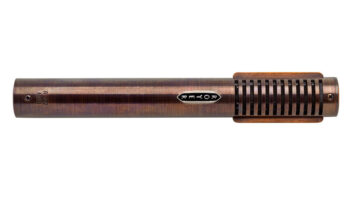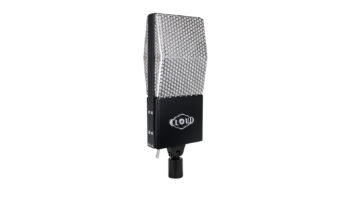
At the past five or so AES shows, Royer’s booth featured a mic with a larger-than-normal gold body. It was introduced as the company’s one-off tube ribbon mic — designed only for test use and as a trade show head-turner. When I asked David Royer if it would ever be released, I always got a response that was hazy at best.
Well, it’s finally here. The R-122V uses the same engine as Royer’s popular R-121 and R-122 mics, based on a low-mass, 2.5-micron thick, 99.99-percent pure-aluminum ribbon and neodymium magnet structure. This is coupled with a triode-configured cathode-follower circuit using a military-grade 5840 tube and a Jensen 1:1 ratio transformer, providing an electrically isolated, fully balanced output signal. The body has been refined from its humble beginnings, making it look more like the slim, traditional design that Royer fans are used to.
INSIDE AND OUT
The R-122V has a dull satin-nickel finish; matte-black chrome is an option. The 1 inch-wide body is a bit more than eight inches long and weighs a mere 10.9 ounces. The kit comes with a multipin connector that screw-locks to the mic and an XLR that attaches to the hefty power supply. From the supply, a standard mic cable connects the mic to the preamp of your choice. Like Royer’s other active ribbons, the circuit eliminates the worries about proper impedance matching at the mic preamp, allows long cable runs without negative impact and boosts level enough so that the traditional noise-floor issues associated with the genre are not troublesome. In other words, any old mic preamp will work, although it’s recommended you use something clean and beautiful with this $2,995 mic.
The supplied shock-mount uses the “follow the logo” design used in other Royer models, meaning that once the mic is properly slid into the mount, wherever the logo points is on-axis. Ports on the side of the mic allow the tube to breathe.
IN THE TRENCHES
I had a matched pair of R-122Vs for this review. I first tried the mics on a drum kit during two sessions, using the pair as overheads, room mics and as knee-highs. I must admit I preferred them when used in the room where their color and transient response were less in evidence. My dream setup combined a pair of BLUE Bottles as overheads with the R-122Vs in the room about eight feet back from the front of the kit in a Blumlein pair. The combination of the brightness of the condensers with the Royers added to taste was a beautiful thing.
Next, I used them on a percussion overdub through a pair of Rupert Neve — designed Summit MPE-200 preamps. The percussionist was playing a Tumba Cajón drum, basically a medium-sized wooden box shaped like and mimicking a conga. The cajón family can have a very sharp transient, especially when played by a drummer who wears a ring. The R-122Vs were placed in an over/under Blumlein pair centered on the drum. They handled all the transients without a problem, yawning where a condenser would flinch. The ribbon’s transient roundness was in evidence, especially when the drummer picked up the pace, producing deliciously warm and rotund peaks. The R-122V nicely tamed the sharp ping of a Vibratone, a metal tube with a hole in it that can be played with a rubber mallet or a stick.
The pair excelled when placed about 1 foot above the hammers of a Yamaha C5 piano, proving to be a bit brighter when compared to Royer’s SF-24 active ribbon. It was simply luscious when put on a raging guitar amp and then a Leslie cabinet, producing a rich bottom end, smooth top and great grind when the Leslie was pumping at full throttle.
The mics were also used to capture a vocalist playing acoustic guitar. Here, the vocal mic was pulled back about 18 inches from the singer while the guitar mic was closer. The pair worked very well together, with great isolation due to the ribbon’s off-axis character. The high-end detail on both the vocal and guitar was beautiful.
RIBBONY SMOOTH
Anyone who has ever discounted a ribbon as too dull or limited for all but a few situations should check out the R-122V. I’ve reviewed quite a few ribbons, and this one has some serious chops on acoustic and electric guitars, percussion, piano and especially on vocals. I heard it used on two male vocalists and in both situations it enhanced the track, sat nicely in the mix without compression and captured a decent amount of top end.
In most situations, surprisingly, the usual woof associated with close miking is reduced, while there is a silky and uncharacteristically extended top end. The R-122V also offers a subtle compressed flavor, explained by David Royer as a bit of a crunch provided when the transformer that folllows the tube is hit hard.
Yes, it’s pricey, but quality is always cheaper in the long run. This mic will have legs as long as you own it. It carries a lifetime warranty for the original owner and a 10-year warranty on the tube, and matched pairs are available at no surcharge. What’s not to like about this one?
Royer Labs, 818/847-0121, www.royerlabs.com.
Kevin Becka is Mix’s technical editor.
